Menus
- Final measurement results in 214.8 hp
- 214.8 hp on the test bench!
- Video of the performance measurement
- Ducati Panigale V4 in four versions
- Runs at the highest level
- Ducati Panigale V4 in the technical check
- There is still room for improvement in terms of speed
- Superbike provides frame corner points
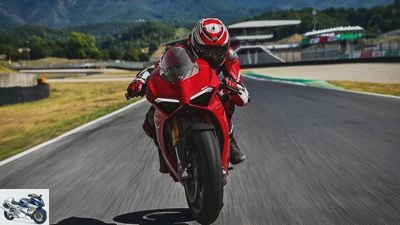
Ducati
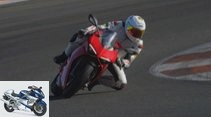
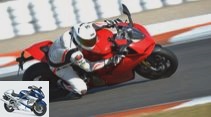
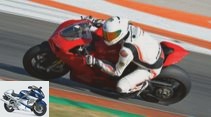
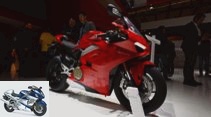
47 photos
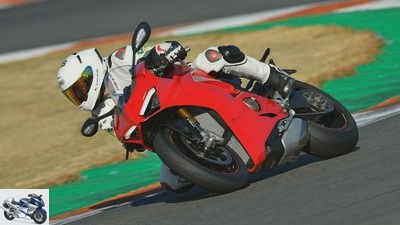
Ducati
1/47
The Ducati Panigale V4 marks the beginning of a new era!
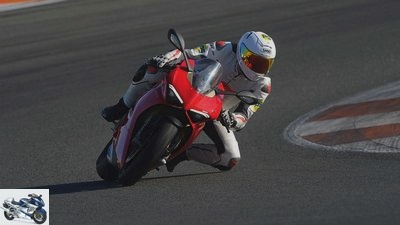
Ducati
2/47
The new V4 engine offers a wide speed range, turns like hell and is still super-smooth.

Ducati
3/47
The electronic control systems all work at the very highest level.

Ducati
4/47
The Ducati Panigale V4 makes a strong first appearance – Chapeau.
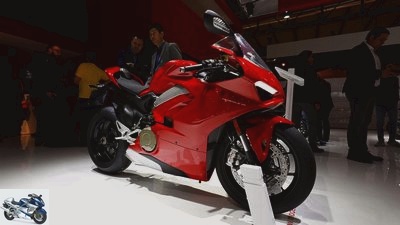
5/47
Ducati Panigale V4 (2018).

6/47
Ducati Panigale V4 S (2018).

Ducati
7/47
Ducati Panigale V4 (2018).

Ducati
8/47
Ducati Panigale V4 (2018).

Ducati
9/47
Ducati Panigale V4 S (2018).
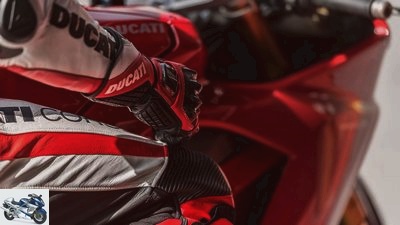
Ducati
10/47
Ducati Panigale V4 (2018).
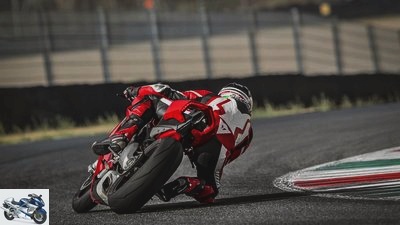
Ducati
11/47
Ducati Panigale V4 (2018).

Ducati
12/47
Ducati Panigale V4 (2018).
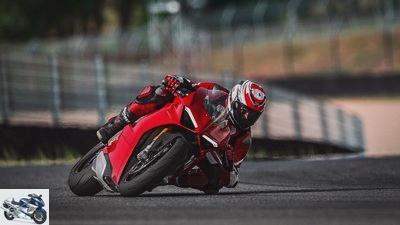
Ducati
13/47
Ducati Panigale V4 (2018).
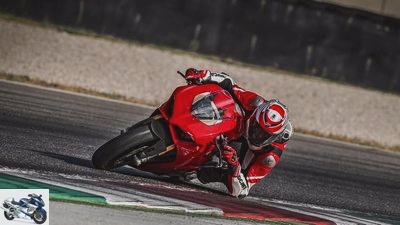
Ducati
14/47
Ducati Panigale V4 (2018).
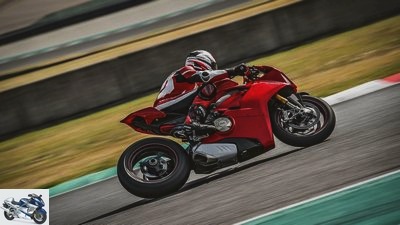
Ducati
15/47
Ducati Panigale V4 (2018).
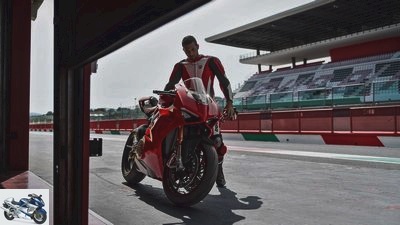
Ducati
16/47
Ducati Panigale V4 (2018).
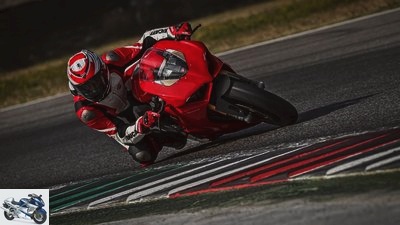
Ducati
17/47
Ducati Panigale V4 (2018).
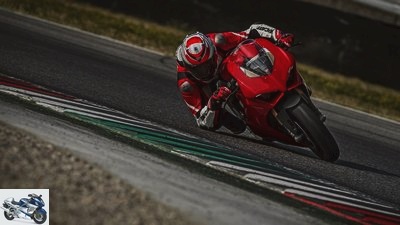
Ducati
18/47
Ducati Panigale V4 (2018).
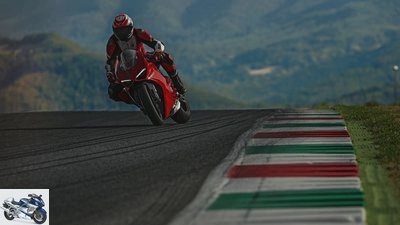
Ducati
19/47
Ducati Panigale V4 (2018).
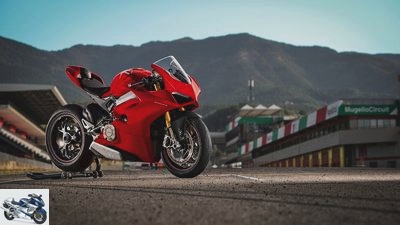
Ducati
20/47
Ducati Panigale V4 (2018).
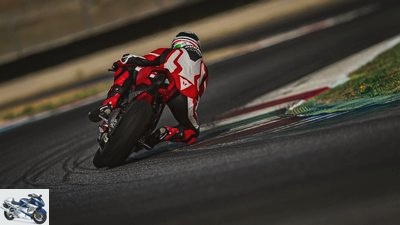
Ducati
21/47
Ducati Panigale V4 (2018).
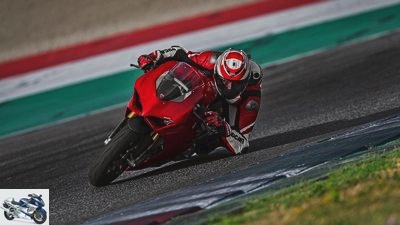
Ducati
22/47
Ducati Panigale V4 (2018).
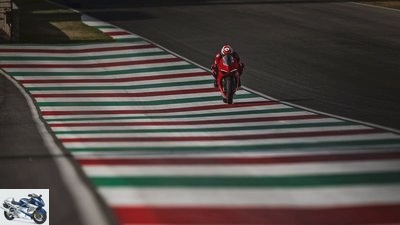
Ducati
23/47
Ducati Panigale V4 (2018).
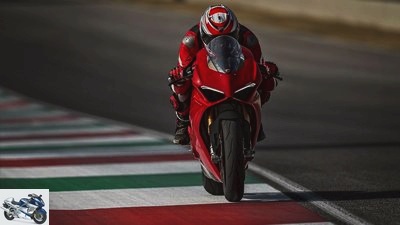
Ducati
24/47
Ducati Panigale V4 (2018).
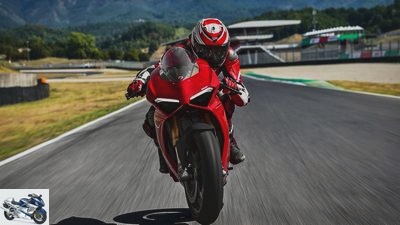
Ducati
25/47
Ducati Panigale V4 (2018).
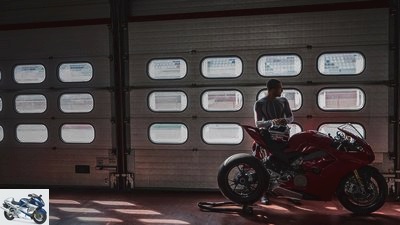
Ducati
26/47
Ducati Panigale V4 (2018).
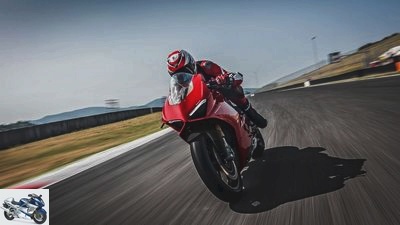
Ducati
27/47
Ducati Panigale V4 (2018).
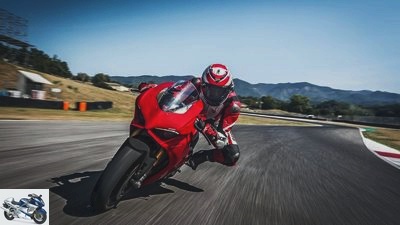
Ducati
28/47
Ducati Panigale V4 (2018).
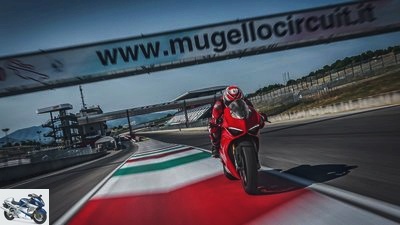
Ducati
29/47
Ducati Panigale V4 (2018).

Ducati
30/47
Ducati Panigale V4 (2018).
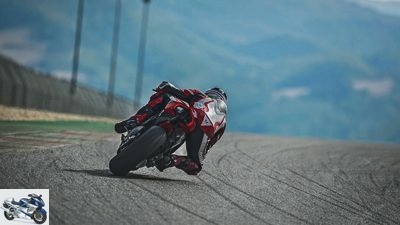
Ducati
31/47
Ducati Panigale V4 (2018).
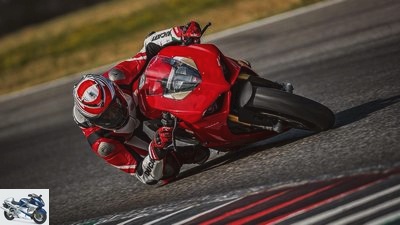
Ducati
32/47
Ducati Panigale V4 (2018).
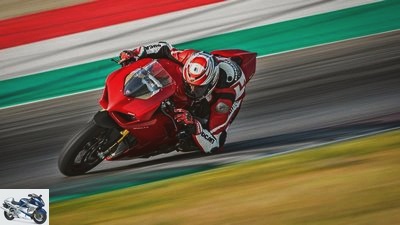
Ducati
33/47
Ducati Panigale V4 (2018).
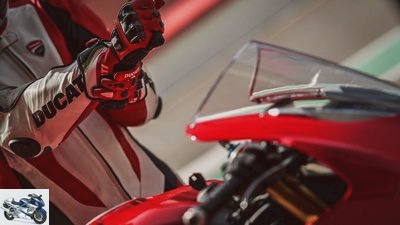
Ducati
34/47
Ducati Panigale V4 (2018).
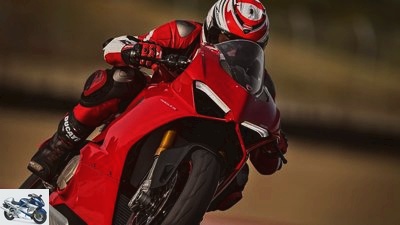
Ducati
35/47
Ducati Panigale V4 (2018).
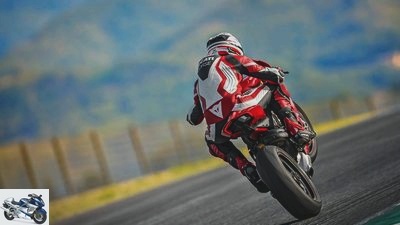
Ducati
36/47
Ducati Panigale V4 (2018).
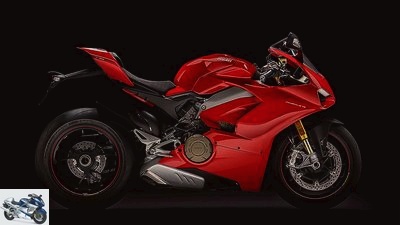
Ducati
37/47
The Panigale V4 means more than a turning point in Ducati’s company history. In the future, the Superbike base will no longer be a V2, but the first production four-cylinder from Bologna – and it uses thoroughbred MotoGP technology for this task.
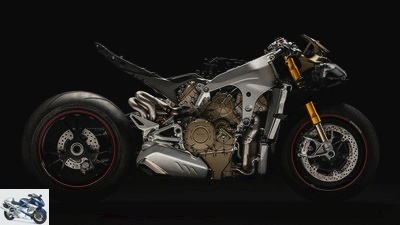
Ducati
38/47
The V4 is sucked into the chassis, the elbows artfully meander to the silencer. The engine is the load-bearing element, but unlike the MotoGP engine, the position of the swing arm cannot be varied, it is fixed in the engine. The engine, tilted 42 degrees backwards, enables a huge radiator wall.
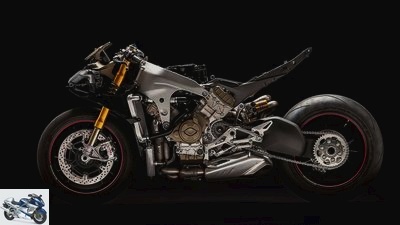
Ducati
39/47
At 600 mm, the single-sided swing arm is one of the longest among the series athletes. You can also imagine the support of the shock absorber on the engine.

Ducati
40/47
The direct comparison clearly shows the close relationship to the MotoGP unit (left). This has a dry clutch and gears for the camshaft drive. The four oil pumps integrated into the engine housing, for example, have both in common.
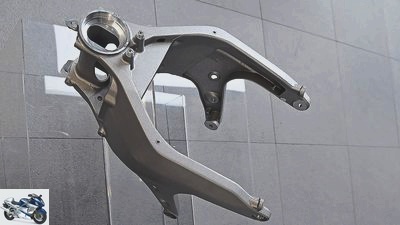
Artist
41/47
The frame weighs just four kilograms. The experiences of Ducati Corse from the MotoGP flowed into the structure and construction of the aluminum chassis.

Ducati
42/47
An intermediate shaft (green) reverses the direction of rotation of the reverse crankshaft (red).
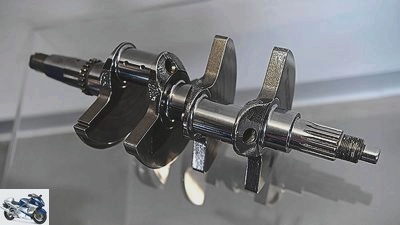
Artist
43/47
Easy to recognize: the unusual crank pin offset of the crankshaft, which ensures the equally unusual twin-pulse firing order of the V4.
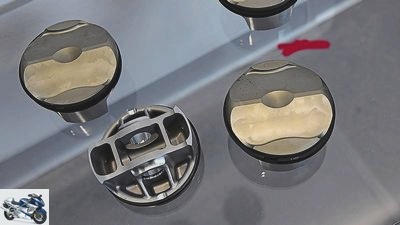
Artist
44/47
Light, forged box pistons with three rings are used in the 1100.

Artist
45/47
The holding points for the strut mount are located at the bottom of the housing. The cylinder head takes up the rear frame.
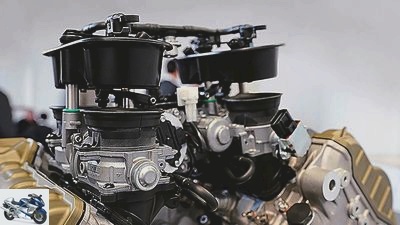
Artist
46/47
At 9,500 and 11,500 rpm, the funnels rise and release short suction paths.
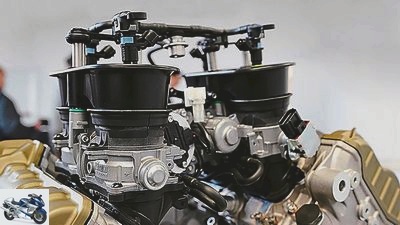
Artist
47/47
In between, at 10,500 rpm, the funnels lower again.
Driving report Ducati Panigale V4
Final measurement results in 214.8 hp
Ducati Panigale V4 and V4 S are equipped with a 1,103 cm³ four-cylinder V-engine. We could already drive the new Super-Duc and had it on the test bench to measure performance.
Light alloy front frame, load-bearing engine, 198 kilograms with a full tank, 21,990 euros – these are the key data. On the performance side, the manufacturer gives for the D.ucati Panigale V4 and its 90-degree V4 have the following data: 214 PS (157.5 kW) at 13,000 rpm and 124 Nm maximum torque at 10,000 rpm.
214.8 hp on the test bench!
We were put to the test with the Ducati Panigale V4 S provided to us to measure performance. Result after the first run-in: 206.9 hp. After 1,800 kilometers, the red rocket was allowed to roll again. The power measurement resulted in a whopping 214.8 hp!
You can read all the details in the comparison test of the V4 and V2 Panigale in MOTORRAD issue 7/2018, from March 16, 2018 at the kiosk and here: Download MOTORRAD as an e-paper
Video of the performance measurement
Ducati Panigale V4 in four versions
The Ducati Panigale V4 S costs 27,990 euros, but with forged wheels and various magnesium holders it weighs another three kilos less (195 kilograms). The Race Replica, which will be based on the V4 Panigale next year, will be even more expensive.
The Ducati Panigale V4 is equipped with a Showa fork and shock absorbers from Sachs, while the Ducati Panigale V4 S uses semi-active Ohlins dampers.
And while we’re already at four on the cylinder side: In addition to the V4, V4 S and Race Replica, a variant called Speciale is also coming onto the market. Features include: carbon components, Akrapovic system and adjustable footrests. The Speciale is priced at 39,900 euros.
In return, there is a real delicacy of modern motorcycle technology in all versions and a production model that rides as close to the MotoGP bike as probably no other at the moment.
Runs at the highest level
The Ducati Panigale V4 marks the beginning of a new era! Cream engine, agile, top electronics and so completely different from the previous V2 models – and yet a real Ducati, which may produce many new Ducatisti.
The new V4 engine offers a wide speed range, turns like hell and is still super-smooth. Acoustically he is not very reserved, hisses wildly and aggressively. Even if it brings plenty of smoothness with its four cylinders, it offers a full punch like the old V2 engines.
The brakes are also of the highest quality. The stoppers deliver top performance and are great to dose. The Panigale itself remains absolutely stable even with the toughest braking maneuvers. The electronic control systems also play a large part in this. They all work at the highest level and can be easily controlled via the ingenious display and the super menu navigation.
The Panigale V4 also delivers an all-round good feeling on the slopes. It just feels great all around, offers crystal-clear feedback and great grip at all times. It’s easier to ride than the old V2 super sports bikes, but still burns itself into our brains as a tough superbike.
The Ducati Panigale V4 makes a strong first appearance – Chapeau. We are already excited about the first comparison test.
Ducati Panigale V4 in the technical check
On November 15, 2017, the new era finally began in Borgo Panigale. On that day, production of the V4 engine started in the Ducati factory.
It is the Red’s first production four-cylinder and will replace the V2 in the superbikes in the future. A revolution. Currently around 20 engines are assembled daily in two-man teams.
Ducati
MotoGP unit (left) and Panigale V4 engine in direct comparison.
According to engine developer Luca Bandiera, the V4 project started back in 2014. And yes, the 2015 MotoGP engine served as the basis for the Panigale V4. In this respect, the new bearer of hope comes directly from the MotoGP missiles. For use in the series engine, however, the complete redesign of the desmodromic system was necessary. After all, this mechanical work of art should only have to be inspected every 15,000 miles.
Because the compression ratio is insanely high at 14: 1, each cylinder head has its own knock sensor. The 90-degree angle of the cylinders guarantees excellent mass balancing, saves a balance shaft and leaves enough space to accommodate the injection system and the water pump integrated in the engine housing in the cylinder V. In the vicinity there is also an intermediate gear that reverses the direction of rotation of the crankshaft. As with the MotoGP engine, the Panigale V4’s crankshaft rotates backwards.
On the one hand this counteracts the gyroscopic forces of the wheels and thus has a positive effect on handling, on the other hand it also reduces the tendency to wheelie and stoppie.
Incidentally, it is the first Ducati engine to have a horizontally split engine housing. According to Bandiera, they are particularly proud of the location of the four oil pumps that guarantee reliable lubrication. A pressure pump circulates the lubricant, three return pumps ensure smooth return transport and a vacuum of up to 0.5 bar in the crankcase in order to keep the power loss due to pumping losses as low as possible.
There is still room for improvement in terms of speed
The nominal speed of the V4 is 13,000 rpm, 2,000 rpm above that of the Superquadro V2. Despite a shorter stroke of 53.5 mm (V2: 60.8 mm), the mean piston speed increases from 22.3 to 23.2 m / s. According to Bandiera, this is still a long way from the 25 m / s that is considered a critical limit value. The subsequent 1000cc V4, which will serve as a superbike base, is to use the same bore and therefore basically the same cylinder heads. It should therefore work with a stroke of around 48.5 mm and be good for speeds of up to 14,500 rpm. The piston speed would still be an acceptable 23.4 m / s. In contrast to the 1100, pistons with only two rings and titanium inlet valves are used.
Artist
The Panigale V4 relies on variable intake funnels
The 1100 relies on box pistons with three rings and steel valves with 5 mm shafts (Panigale 1299: 7 mm). Unlike the MotoGP engine, the Panigale V4 does not use gear towers to control the camshafts, but rather short chains for reasons of cost and noise that drive the inlet camshaft on the front cylinder bank and the exhaust camshaft on the rear. They transmit their rotation to the second camshaft via a gear. He slurps his mixture through CNC-milled intake ducts.
A special feature of the V4, which, like the direction of rotation of the crankshaft, it has inherited from the MotoGP engine: its firing order, known as Twin-Pulse.
First the left cylinder pair ignites, then the right one. The crank pin offset of 70 degrees results in a firing order of 0 ° -90 ° -290 ° -380 °. This is followed by 340 degrees of crankshaft rotation without ignition, in which the rear tire can recover. What traction and tire wear benefit from.
The variable intake trumpets are another delicacy. At 9,500 rpm, they go up within 300 ms and shorten the intake paths. 1,000 / min later, they sit down again, only to lift another 1,000 / min later and stay there up to the limiter.
This up-down-high should consistently provide over 120 Nm of torque and the enormous peak output of 214 hp between 9,000 and 11,500 rpm. Which, by the way, corresponds to a class-standard liter output of 194 hp. In view of the torque promise, it is more than awe inspiring. Especially with a race kit, which should add another 12 hp and 7 Nm.
The engine acts as a load-bearing element in the frame. Not only are the front frame weighing just under four kilograms and the shock absorber supported by the engine housing. It also carries the rear frame and the swing arm mounting.
Superbike provides frame corner points
The starting point for the frame geometry was the V2 superbike, according to project manager Stefano Strapazzon. But when it comes to the installation position, the pivot point of the 600 mm long swing arm and the rigidity, Ducati Corse has given a lot of input. And why an aluminum and not a tubular frame? “The aluminum frame is derived from the MotoGP frame,” explains Strapazzon. “It offers the best compromise between weight and performance. In addition, changes to wall thicknesses, for example, can be made faster and easier. “
Ducati
The V2 superbike was the inspiration for the chassis.
The aluminum chassis should combine high braking stability and sufficient flex to absorb waves in an inclined position. The long front arm also ensures that the force is absorbed evenly. And last but not least, you can rely on valuable input from Ducati Corse when tuning the chassis. As with the weight distribution. While it was still 50/50% (front / rear) for the 1098, it has now shifted over 53/47% for the V2 Panigale to 54.5% at the front and 45.5% at the rear for the V4. According to Strapazzon, this value has proven to be optimal. For this purpose, for example, the lithium battery was moved under the tank cover behind the steering head, while the aluminum tank extends under the seat.
Because small cattle also make crap, the magnesium alloy housing covers are fastened with around 50 aluminum screws. And the Stylema 4.30 radial brake calipers developed together with Brembo save an additional 70 grams compared to the M50 calipers. Do not mess, that’s what electronics meant. Not only because of the semi-active Ohlins spring elements that adorn the noble S version. Based on a six-axis IMU, the Panigale V4 has a three-stage Bosch lean angle ABS, suitable for the race track, can be switched off at the rear for clean drifts, which are also monitored by the Slide Control (DSC) and the EVO engine brake control (EBC EVO). In addition, the automatic gearshift (up and down) now works depending on the lean angle, so that gear changes in bends cause as little unrest in the chassis as possible.
Related articles
-
Driving report Aprilia RXV 4.5
Soldano driving report Aprilia RXV 4.5 on new paths V-twin-cylinder, petrol injection, unusual framework concept ?? two years ago surprised …
-
Driving report Yamaha YZ 400 F
Driving report Yamaha YZ 400 F Menopause Times are changing: Small four-stroke crossers will come and the sedate steam hammers like the poisonous …
-
Comparison test Ducati Panigale V4 S and Ducati 1299 Panigale S.
factstudio.de 21 pictures factstudio.de 1/21 Ducati Panigale V4 S and Ducati 1299 Panigale S in a comparison test. factstudio.de 2/21 Two TFT displays ….
-
Ducati V4 R (2019) in the driving report
Motorcycle fair in Milan EICMA 2019 Presented by Ducati 31 images Ducati 1/31 We were already able to drive the new Ducati V4 R in Jerez. Ducati 2/31 …
-
Ducati 11 pictures Ducati 1/11 Freshly presented at the IAA: the new Ducati 899 Panigale. Ducati 2/11 The Ducati 899 Panigale is supposed to bridge the gap between …
-
Ducati driving report Ducati GT 1000 The first and the last Inspired by the past: The GT 1000 bows to the first series Duc with …
-
Driving report Bimota SB 6 R Draft horse Often promised – never kept. Only the SB 6 R has what the SB 6 was previously lacking: power and performance. The thing …
-
Driving report Aprilia RSX 550
Bilski driving report Aprilia RSX 550 self-made Supersport After the 250cc two-stroke engines and lively 400cc four-stroke engines, which were canceled without replacement …
-
Driving report Suzuki TL 1000 R
Driving report Suzuki TL 1000 R On probation With the super sporty TL 1000 R, Suzuki wants to prove that despite massive starting difficulties with the TL …
-
Driving report Honda CRF 250 X
Driving report Honda CRF 250 X By Sascha Zdrahal; Photos: fact Since the blessed XR days, the first real competition Enduro from Honda has been in the …